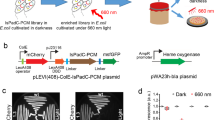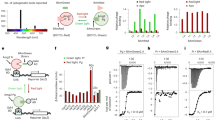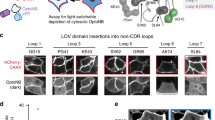Abstract
Multifunctional optogenetic systems are in high demand for use in basic and biomedical research. Near-infrared-light-inducible binding of bacterial phytochrome BphP1 to its natural PpsR2 partner is beneficial for simultaneous use with blue-light-activatable tools. However, applications of the BphP1–PpsR2 pair are limited by the large size, multidomain structure and oligomeric behavior of PpsR2. Here, we engineered a single-domain BphP1 binding partner, Q-PAS1, which is three-fold smaller and lacks oligomerization. We exploited a helix–PAS fold of Q-PAS1 to develop several near-infrared-light-controllable transcription regulation systems, enabling either 40-fold activation or inhibition. The light-induced BphP1–Q-PAS1 interaction allowed modification of the chromatin epigenetic state. Multiplexing the BphP1–Q-PAS1 pair with a blue-light-activatable LOV-domain-based system demonstrated their negligible spectral crosstalk. By integrating the Q-PAS1 and LOV domains in a single optogenetic tool, we achieved tridirectional protein targeting, independently controlled by near-infrared and blue light, thus demonstrating the superiority of Q-PAS1 for spectral multiplexing and engineering of multicomponent systems.
This is a preview of subscription content, access via your institution
Access options
Access Nature and 54 other Nature Portfolio journals
Get Nature+, our best-value online-access subscription
$29.99 / 30 days
cancel any time
Subscribe to this journal
Receive 12 print issues and online access
$259.00 per year
only $21.58 per issue
Buy this article
- Purchase on Springer Link
- Instant access to full article PDF
Prices may be subject to local taxes which are calculated during checkout





Similar content being viewed by others
References
Deisseroth, K. Optogenetics. Nat. Methods 8, 26–29 (2011).
Shcherbakova, D.M., Shemetov, A.A., Kaberniuk, A.A. & Verkhusha, V.V. Natural photoreceptors as a source of fluorescent proteins, biosensors, and optogenetic tools. Annu. Rev. Biochem. 84, 519–550 (2015).
Wang, X., Chen, X. & Yang, Y. Spatiotemporal control of gene expression by a light-switchable transgene system. Nat. Methods 9, 266–269 (2012).
Strickland, D. et al. TULIPs: tunable, light-controlled interacting protein tags for cell biology. Nat. Methods 9, 379–384 (2012).
Niopek, D. et al. Engineering light-inducible nuclear localization signals for precise spatiotemporal control of protein dynamics in living cells. Nat. Commun. 5, 4404 (2014).
Yumerefendi, H. et al. Control of protein activity and cell fate specification via light-mediated nuclear translocation. PLoS One 10, e0128443 (2015).
Niopek, D., Wehler, P., Roensch, J., Eils, R. & Di Ventura, B. Optogenetic control of nuclear protein export. Nat. Commun. 7, 10624 (2016).
Kennedy, M.J. et al. Rapid blue-light-mediated induction of protein interactions in living cells. Nat. Methods 7, 973–975 (2010).
Taslimi, A. et al. An optimized optogenetic clustering tool for probing protein interaction and function. Nat. Commun. 5, 4925 (2014).
Wang, H. et al. LOVTRAP: an optogenetic system for photoinduced protein dissociation. Nat. Methods 13, 755–758 (2016).
Guntas, G. et al. Engineering an improved light-induced dimer (iLID) for controlling the localization and activity of signaling proteins. Proc. Natl. Acad. Sci. USA 112, 112–117 (2015).
Taslimi, A. et al. Optimized second-generation CRY2-CIB dimerizers and photoactivatable Cre recombinase. Nat. Chem. Biol. 12, 425–430 (2016).
Bhoo, S.H., Davis, S.J., Walker, J., Karniol, B. & Vierstra, R.D. Bacteriophytochromes are photochromic histidine kinases using a biliverdin chromophore. Nature 414, 776–779 (2001).
Toettcher, J.E., Weiner, O.D. & Lim, W.A. Using optogenetics to interrogate the dynamic control of signal transmission by the Ras/Erk module. Cell 155, 1422–1434 (2013).
Buckley, C.E. et al. Reversible optogenetic control of subcellular protein localization in a live vertebrate embryo. Dev. Cell 36, 117–126 (2016).
Ulijasz, A.T. & Vierstra, R.D. Phytochrome structure and photochemistry: recent advances toward a complete molecular picture. Curr. Opin. Plant Biol. 14, 498–506 (2011).
Piatkevich, K.D., Subach, F.V. & Verkhusha, V.V. Engineering of bacterial phytochromes for near-infrared imaging, sensing, and light-control in mammals. Chem. Soc. Rev. 42, 3441–3452 (2013).
Shcherbakova, D.M., Baloban, M. & Verkhusha, V.V. Near-infrared fluorescent proteins engineered from bacterial phytochromes. Curr. Opin. Chem. Biol. 27, 52–63 (2015).
Shcherbakova, D.M. & Verkhusha, V.V. Near-infrared fluorescent proteins for multicolor in vivo imaging. Nat. Methods 10, 751–754 (2013).
Kaberniuk, A.A., Shemetov, A.A. & Verkhusha, V.V. A bacterial phytochrome-based optogenetic system controllable with near-infrared light. Nat. Methods 13, 591–597 (2016).
Bellini, D. & Papiz, M.Z. Structure of a bacteriophytochrome and light-stimulated protomer swapping with a gene repressor. Structure 20, 1436–1446 (2012).
Braatsch, S., Johnson, J.A., Noll, K. & Beatty, J.T. The O2-responsive repressor PpsR2 but not PpsR1 transduces a light signal sensed by the BphP1 phytochrome in Rhodopseudomonas palustris CGA009. FEMS Microbiol. Lett. 272, 60–64 (2007).
Heintz, U., Meinhart, A. & Winkler, A. Multi-PAS domain-mediated protein oligomerization of PpsR from Rhodobacter sphaeroides. Acta Crystallogr. D Biol. Crystallogr. 70, 863–876 (2014).
Winkler, A. et al. A ternary AppA-PpsR-DNA complex mediates light regulation of photosynthesis-related gene expression. Nat. Struct. Mol. Biol. 20, 859–867 (2013).
Mallo, M. Controlled gene activation and inactivation in the mouse. Front. Biosci. 11, 313–327 (2006).
Bacchus, W., Aubel, D. & Fussenegger, M. Biomedically relevant circuit-design strategies in mammalian synthetic biology. Mol. Syst. Biol. 9, 691 (2013).
Whiteside, S.T. & Goodbourn, S. Signal transduction and nuclear targeting: regulation of transcription factor activity by subcellular localisation. J. Cell Sci. 104, 949–955 (1993).
Hong, M. et al. Structural basis for dimerization in DNA recognition by Gal4. Structure 16, 1019–1026 (2008).
Delorenzi, M. & Speed, T. An HMM model for coiled-coil domains and a comparison with PSSM-based predictions. Bioinformatics 18, 617–625 (2002).
Gautier, R., Douguet, D., Antonny, B. & Drin, G. HELIQUEST: a web server to screen sequences with specific alpha-helical properties. Bioinformatics 24, 2101–2102 (2008).
Laherty, C.D. et al. Histone deacetylases associated with the mSin3 corepressor mediate mad transcriptional repression. Cell 89, 349–356 (1997).
Xie, M., Haellman, V. & Fussenegger, M. Synthetic biology-application-oriented cell engineering. Curr. Opin. Biotechnol. 40, 139–148 (2016).
Blancafort, P., Segal, D.J. & Barbas, C.F. III. Designing transcription factor architectures for drug discovery. Mol. Pharmacol. 66, 1361–1371 (2004).
Ayer, D.E., Laherty, C.D., Lawrence, Q.A., Armstrong, A.P. & Eisenman, R.N. Mad proteins contain a dominant transcription repression domain. Mol. Cell. Biol. 16, 5772–5781 (1996).
Burcin, M.M., Schiedner, G., Kochanek, S., Tsai, S.Y. & O'Malley, B.W. Adenovirus-mediated regulable target gene expression in vivo. Proc. Natl. Acad. Sci. USA 96, 355–360 (1999).
Ornitz, D.M., Moreadith, R.W. & Leder, P. Binary system for regulating transgene expression in mice: targeting int-2 gene expression with yeast GAL4/UAS control elements. Proc. Natl. Acad. Sci. USA 88, 698–702 (1991).
Dong, Z., Peng, J. & Guo, S. Stable gene silencing in zebrafish with spatiotemporally targetable RNA interference. Genetics 193, 1065–1071 (2013).
Lewandoski, M. Conditional control of gene expression in the mouse. Nat. Rev. Genet. 2, 743–755 (2001).
Anantharaman, V., Balaji, S. & Aravind, L. The signaling helix: a common functional theme in diverse signaling proteins. Biol. Direct 1, 25 (2006).
Yumerefendi, H. et al. Light-induced nuclear export reveals rapid dynamics of epigenetic modifications. Nat. Chem. Biol. 12, 399–401 (2016).
Arnoys, E.J. & Wang, J.L. Dual localization: proteins in extracellular and intracellular compartments. Acta Histochem. 109, 89–110 (2007).
Ausländer, S. & Fussenegger, M. Engineering gene circuits for mammalian cell-based applications. Cold Spring Harb. Perspect. Biol. 8, a023895 (2016).
Müller, K. et al. Multi-chromatic control of mammalian gene expression and signaling. Nucleic Acids Res. 41, e124 (2013).
Webb, B. & Sali, A. Protein structure modeling with MODELLER. Methods Mol. Biol. 1137, 1–15 (2014).
Pettersen, E.F. et al. UCSF Chimera--a visualization system for exploratory research and analysis. J. Comput. Chem. 25, 1605–1612 (2004).
Piatkevich, K.D., Subach, F.V. & Verkhusha, V.V. Far-red light photoactivatable near-infrared fluorescent proteins engineered from a bacterial phytochrome. Nat. Commun. 4, 2153 (2013).
Alland, L. et al. Identification of mammalian Sds3 as an integral component of the Sin3/histone deacetylase corepressor complex. Mol. Cell. Biol. 22, 2743–2750 (2002).
Acknowledgements
We thank M. Papiz (Liverpool University, UK), E. Giraud (Institute for Research and Development, France), W. Weber (University of Freiburg, Germany) and F. Zhang (Broad Institute of MIT and Harvard, USA) for plasmids, and A. Leopold (University of Helsinki), A. Kaberniuk and A. Shemetov (both from Albert Einstein College of Medicine) for useful suggestions. We thank Biomedicum Imaging Unit, AAV Gene Transfer and Cell Therapy and Biomedicum Flow Cytometry core facilities staff (University of Helsinki) for the technical assistance. This work was supported by grants GM105997, GM108579 and NS099573 from the US National Institutes of Health, ERC-2013-ADG-340233 from the EU FP7 program, and 263371 and 266992 from the Academy of Finland.
Author information
Authors and Affiliations
Contributions
T.A.R. and K.G.C. characterized the proteins in vitro, and T.A.R., E.S.O. and K.G.C. analyzed the optogenetic pair in mammalian cells. V.V.V. planned and directed the project and together with T.A.R., E.S.O. and K.G.C. designed the experiments, analyzed the data and wrote the manuscript.
Corresponding author
Ethics declarations
Competing interests
The authors declare no competing financial interests.
Supplementary information
Supplementary Text and Figures
Supplementary Results, Supplementary Tables 1–3 and Supplementary Figures 1–18 (PDF 2816 kb)
Supplementary Video 1
Sequential light-induced relocalization of the iRIS tool from a cytoplasm to the nucleus and to the plasma membrane in a single cell after the illumination periods (either 5 min with 460 nm of 1 mW cm−2 or 5 min with 740 nm of 1 mW cm−2 light) followed by the dark relaxation periods. (AVI 33424 kb)
Rights and permissions
About this article
Cite this article
Redchuk, T., Omelina, E., Chernov, K. et al. Near-infrared optogenetic pair for protein regulation and spectral multiplexing. Nat Chem Biol 13, 633–639 (2017). https://doi.org/10.1038/nchembio.2343
Received:
Accepted:
Published:
Issue Date:
DOI: https://doi.org/10.1038/nchembio.2343
This article is cited by
-
Engineering of bidirectional, cyanobacteriochrome-based light-inducible dimers (BICYCL)s
Nature Methods (2023)
-
A red light–responsive photoswitch for deep tissue optogenetics
Nature Biotechnology (2022)
-
Optogenetic manipulation and photoacoustic imaging using a near-infrared transgenic mouse model
Nature Communications (2022)
-
Synthetic protein condensates for cellular and metabolic engineering
Nature Chemical Biology (2022)
-
A guide to the optogenetic regulation of endogenous molecules
Nature Methods (2021)



